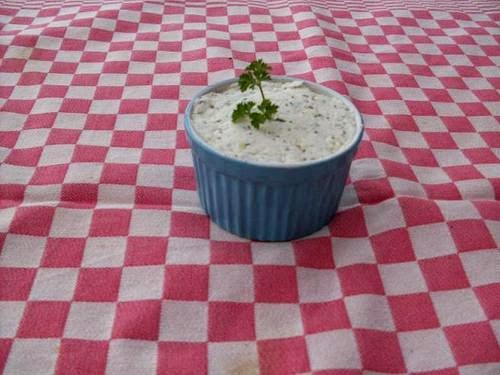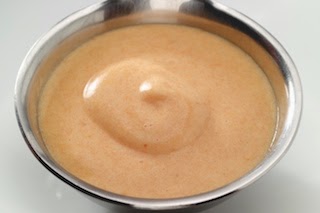As I wasn't born in the UK, I missed out on some wonderful foods growing up. For instance crumpets and potato cakes but also spam fritters, treacle tart and 'fly pie'. And I have had to do without toad-in-the-hole, Yorkshire puddings and the illustrious dish called wigwams (a pile of cheese-y mash with three sausages (placed upright around the mash to form a teepee) with a 'moat' of baked beans in tomato sauce). Life just isn't fair sometimes...
What I did grow up with though are frikandellen, kroketten and stamppot. The Dutch (and Belgians) have a love for the deep-fat fryer, although I had never even heard of a deep fried mars bar and have yet to taste this concoction... We do, however, deep fry cheese souffles (although they are not the kind that you would normally bake in the oven) and egg fried rice. When people ask me if I miss anything from back there, frikandel and kaassoufflé are my first answers. But that is only because I still haven't been able to find a good recipe to make them at home.
Stamppot (which is basically a type of bubble and squeak) is something that I make quite regularly and my husband loves it, especially when made with Brussels sprouts or curly kale. But it's kroketten that I got him hooked on. The French call them croquettes, very posh for something very simple. Meat, poultry, vegetables, cheese or even fish in a very thick white or brown sauce (Béchamel, Velouté or Espagnole) encased in breadcrumbs, fried until golden and crispy.
There are some conflicting stories going round as to where the kroket originates but clear is that it was used as a way of getting rid of leftovers and were often served as a starter to a meal. Later they also became popular at parties in the form of golf ball sized bites, called bitterbal. The base for the kroket is always the same; a very thick 'ragout' made of either Béchamel, Velouté or Espagnole and a filling. The filling itself, as you can imagine, can be as diverse as you want it to be. This is perfect as you can adjust the filling to likes and dislikes but also in regards of cultural, religious or self-imposed dietary restrictions.
Ingredients:
Chop the meat very finely or pull apart with two forks
What I did grow up with though are frikandellen, kroketten and stamppot. The Dutch (and Belgians) have a love for the deep-fat fryer, although I had never even heard of a deep fried mars bar and have yet to taste this concoction... We do, however, deep fry cheese souffles (although they are not the kind that you would normally bake in the oven) and egg fried rice. When people ask me if I miss anything from back there, frikandel and kaassoufflé are my first answers. But that is only because I still haven't been able to find a good recipe to make them at home.
Stamppot (which is basically a type of bubble and squeak) is something that I make quite regularly and my husband loves it, especially when made with Brussels sprouts or curly kale. But it's kroketten that I got him hooked on. The French call them croquettes, very posh for something very simple. Meat, poultry, vegetables, cheese or even fish in a very thick white or brown sauce (Béchamel, Velouté or Espagnole) encased in breadcrumbs, fried until golden and crispy.
There are some conflicting stories going round as to where the kroket originates but clear is that it was used as a way of getting rid of leftovers and were often served as a starter to a meal. Later they also became popular at parties in the form of golf ball sized bites, called bitterbal. The base for the kroket is always the same; a very thick 'ragout' made of either Béchamel, Velouté or Espagnole and a filling. The filling itself, as you can imagine, can be as diverse as you want it to be. This is perfect as you can adjust the filling to likes and dislikes but also in regards of cultural, religious or self-imposed dietary restrictions.
Ingredients:
- 600 gram cooked beef (either from making stock or use the beef from your favourite beef stew)
- 1 onion, chopped
- 4 tablespoons butter
- 4 tablespoons flour
- ½ liter stock or milk
- pepper,salt, mace, nutmeg to taste
- flour
- eggs or egg whites
- (toasted) breadcrumbs
- Oil (or fat such as lard) for frying
Method:
- I prefer to use homemade beef stew that I cook for so long (3-4 hours) that the beef falls apart when pressed with a fork or spoon
- Melt the butter on medium heat and add the flour as soon as the butter stops foaming
- Stir the flour and butter on medium heat until it turns a golden colour (3-4 minutes) (this makes a roux) and add the stock or milk
- I prefer to use the liquid that is left over from the beef stew, with some water or stock added to make up the volume
- Whisk the sauce for about 2-3 minutes to cook out the flour and add the spices and the beef (this makes a ragout)
- Leave the ragout to cool completely
- To make the kroketten it is easiest to do so when the ragout is very cold so I tend to make the ragout at least a day in advance
- You can keep the ragout in the fridge until needed but can also be frozen for a later date
- Once you are ready to make the kroketten, prepare three bowls (or soup plates):
- (seasoned) flour
- lightly beaten eggs or egg whites
- breadcrumbs
- Lightly flour your hands and form the ragout into sticks of about 10 by 3 cm
- If necessary, return the formed kroketten to the fridge as it is easier to bread them when they are cold
- Cover each kroket in flour, then egg, then breadcrumbs making sure to cover the kroketten completely otherwise the ragout could leak out during the deep fat frying
- Try using one hand for the flour and breadcrumb and the other hand for the egg
- You can repeat this step for a thicker, crispier crust and to ensure that the kroketten won't leak during frying
- Place the breaded kroketten in the fridge for about 30 minutes to firm up
- Heat the fat to about 180oC
- Fry the kroketten, in batches, for about 4 minutes until golden brown
- Remove the kroketten from the pan onto some paper towels to drain any excess fat
The list of fillings you can use is only limited to your own preferences and imagination but here are some ideas:
Meat kroketten: You can use any soup meat (beef, chicken) but also veal or lamb, and lovely kroketten are made with sweetbreads.
Cheese kroketten: use milk in making the roux, replace the meat with cheese and season to taste with white pepper, nutmeg and parsley. I like to grate about 400 gram of the cheese into the sauce before cooling and add the leftover cheese once cold. You can use almost any cheese you like (Gouda, Stilton, Roquefort, Cheddar), but I find that very old or dry cheeses like Parmigiana Reggiano or old Pecorino are better when you combine them with other cheeses.
Fish kroketten: Use fish stock, and herbs like dill or chives.
Game kroketten: For these you use a brown roux: Let the butter colour slightly more before adding flour, keep the fire higher than when making a blond roux, cook the butter/flour paste a little longer. Use more butter/flour than for a blond roux, 70 gram each for a half litre of liquid. Use good (game) stock for the sauce.
Vegetable kroketten: Make a blond roux with milk or vegetable stock, add blanched vegetables like asparagus, broccoli, peas). You can add some cheese and herbs to taste. Mushroom kroketten are better with a ragout made with meat stock (or the liquid that dried mushrooms have been steeped in).
Cheese kroketten: use milk in making the roux, replace the meat with cheese and season to taste with white pepper, nutmeg and parsley. I like to grate about 400 gram of the cheese into the sauce before cooling and add the leftover cheese once cold. You can use almost any cheese you like (Gouda, Stilton, Roquefort, Cheddar), but I find that very old or dry cheeses like Parmigiana Reggiano or old Pecorino are better when you combine them with other cheeses.
Fish kroketten: Use fish stock, and herbs like dill or chives.
Game kroketten: For these you use a brown roux: Let the butter colour slightly more before adding flour, keep the fire higher than when making a blond roux, cook the butter/flour paste a little longer. Use more butter/flour than for a blond roux, 70 gram each for a half litre of liquid. Use good (game) stock for the sauce.
Vegetable kroketten: Make a blond roux with milk or vegetable stock, add blanched vegetables like asparagus, broccoli, peas). You can add some cheese and herbs to taste. Mushroom kroketten are better with a ragout made with meat stock (or the liquid that dried mushrooms have been steeped in).
Have fun making your own variations and enjoy with your choice of condiment; mine is very traditional: mustard.
As they say in The Netherlands
Eet smakelijk
Or, in just plain old English
Enjoy



































